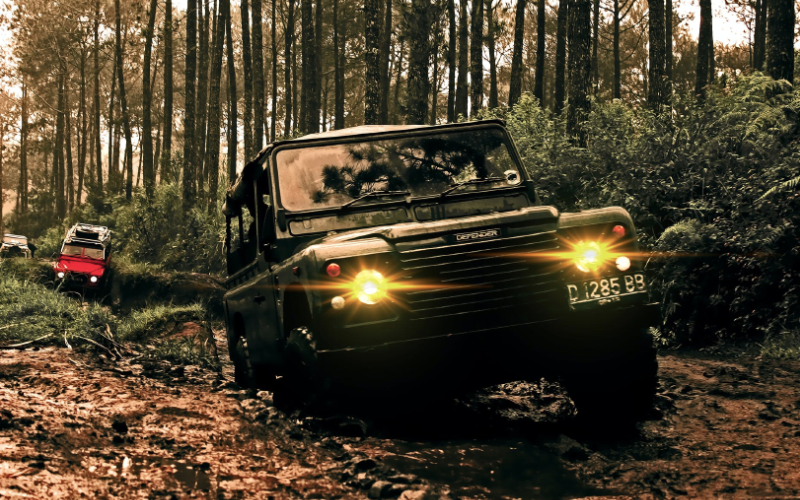Driving off-road is one of the most thrilling experiences that you can have behind the wheel. New technologies and more vehicle options have changed off-roading from a fringe hobby into a more mainstream hobby enjoyed by countless people around the world.
Once you’ve mastered some of the basics, however, how can you “level up” in the world of off-roading? This is the topic of today’s blog. We are exploring the question of how one can go from the beginner and low-intermediate levels of off-roading up to a more advanced set of skills.
What are the “Basics” of Off-Roading?
In order to know how one might get to a higher level, we should be first be clear about what constitutes a “basic” level of off-roading. What are the fundamental skills that every off-roader should have mastered before moving to the upper echelons of their new-found hobby?
Knowing the Vocabulary
First of all, if you have been off-roading and understand all of the following terms, then you have the first stage of off-road basics:
- Approach Angle: Maximum incline angle that your vehicle can ascend or descend without the suspension or any part of the body or undercarriage touching the ground surface.
- 4×4 Low: A lower-gear-ratio 4WD mode that gives you higher torque. It’s the best way of getting out of jam, or when you want to attempt rock crawling.
- Wheelbase: The distance from the center of your vehicle’s front wheel to the center of the rear wheel on the same side.
- Wheel Travel: How far a wheel can move up and down. To increase the travel, you can install a better suspension system. Greater travel gives better traction.
- Locking Differential: The speed at which your wheels turn. In a normal 4WD mode, the wheels are moving at slightly different speeds to help you over uneven terrain. The locking differential, or “diff lock” is a tool to lock your wheels at the same speed whenever you get stuck or are traversing very tricky terrain.
Packing the Essentials
If you remember to bring all of the following things, then you are at least an off-roading beginner who knows the score: a full tank of gas, navigational aids, a smartphone with additional charger, a shovel, a two-way radio, a portable air compressor, a spare tire, a tow rope and a first-aid kit.
Basic Off-Road Driving Types
When you start out in off-roading there are several things you will master to gain your “novice” stripes. These things include (but are not necessarily limited to):
- Trail driving: Riding on gravel, dry dirt or across grasslands. It’s pretty much the simplest form of off-roading you can do.
- Sand driving: Whether you’re on a beach or in some open desert, driving across flat sand is essentially a step up from trail driving, but still on the easier side.
- Mud driving: Of all the basic-level skills, mud is probably the most challenging. It means being able to retain control in slippery conditions, and also stop your wheels from descending into a spin. The skills you’ve gained on sand will apply very well to your mud driving.
And there you have it, if all the above things apply to you and appear familiar and things that you have done in your own 4-wheel-drive off-roading vehicle, then you are at the very least a competent off-roading novice. You are now ready to explore the possibilities of expanding your skills to a more advanced level.
How to Improve Your Off-Roading Skills
Next, then you’ll want ideas on how to boost your skills. The following things we recommend to all off-roaders willing to try, but remember never to overestimate your or your vehicle’s capabilities. No amount of off-road experience is ever worth risking your health and safety for.
1. Expand Your On-Road Driving Skills
We’ll assume that if you’re mastered the basics of off-roading, then you are a licensed driver who knows how a vehicle works, too. That’s fine, but in fact the first place to start improving your off-roading skills is on the road. Advanced driving courses can hold the key to laying stronger foundations upon which you can build greater off-road driving abilities.
In such courses, you will learn a number of interesting advanced and defensive driving skills. These are originally designed to help you avoid crashes and other accidents. You’ll be surprised how well they apply to the world of off-roading, because what they teach more fundamentally to drivers is how to read and understand the limits of themselves as drivers, and the limits of their vehicle. That’s a crucial point when you’re off-roading. Here are some of the skills you learn:
- Posture – What seating position to maintain in order to retain maximum control of your vehicle.
- Steering – How to respond with the wheel in different situations in order to maintain full control of a vehicle.
- High-Speed Maneuvers – The courses often involve learning to drive a “slalom” where you weave in and out of cone obstacles, and you’ll also probably learn to perform a high-speed emergency lane change. Such things teach you to manage your vehicle even when going at speed.
- Limitations of Vehicle Tech – Your vehicle is loaded with driver assistance tech like ABS, ESC, traction control and so on. Advanced courses help you push these systems to their limit so you can see for yourself what the maximum they can really do is.
- Skid and Slide Prevention – How to know when your vehicle is skidding or sliding and how to respond either to recover or avoid it altogether by spotting it before it happens.
The list goes on. As you read these, hopefully you can see that they have a clear application to off-roading. Understanding how much your off-road vehicle is capable of, including the capabilities of its various systems is absolutely crucial. Those who overestimate their ability or that of their vehicle tend to end up in what’s known as a “rock massage,” which can be as physically and emotionally painful as it sounds.
Other useful things you can do in everyday driving that can have some benefit to your off-roading skills include:
- Driving with a trailer – towing in general teaches you to be more mindful of the vehicle and what’s going on around you.
- Testing your vehicle’s 4WD and other drive modes. Getting familiar with all the drive modes that your off-road vehicle can do by testing them out in controlled environments can be a helpful exercise.
2. Focus on Momentum, but Not Speed
Some aspiring off-roaders have in their minds an image of a rally car streaking through a forest like one of those jet bikes from Return of the Jedi. Off-roading is actually more often a much slower game than that. A skilled off-road driver knows that the key is not speed, but momentum. Keeping the vehicle moving forward or at least able to move forward is your ultimate and most trying task.
When you start your off-roading adventures, you begin on simple gravel trails, possible a beach or other relatively flat and straightforward surface. These are what you need to acclimatize to the off-roading world, but they are the simplest manifestations of off-road terrains. On such ground, you can build up speed and enjoy the thrill of throwing up dust, dirt and mud as you experience a new asphalt-less world of driving.
When you are attempting to traverse rocks, towering sand dunes, and steep mountain trails, however, you will not be thinking about to rocket through all of that. You’ll be wondering how to traverse these obstacles without rolling backwards — or worse, rolling over!
To master momentum, you need to first practice driving slowly and patiently. You’ll also need to stop from time to time and read the terrain ahead to figure out a game plan for managing the vehicle’s drive functions, torque and acceleration in order to beat each tricky spot on the trail. This is why you don’t off-road alone. The person accompanying you is a bit like a golf caddy. Where a caddy suggests clubs to use for the shot ahead, a spotter in your off-road vehicle helps look for hazards ahead and how to overcome them. They can help you time your shifts in speed and torque to best traverse the terrain, and will also offer some stern warnings if the approaching obstacle is at an angle that your vehicle’s approach angle can’t handle. All of this is in the name of maintaining momentum.
3. Practice Getting Stuck and then Getting Out Again
You spend most of your time as a beginner practicing not getting stuck in any situation. That was helpful when you were cutting your teeth on your first trails. If you want to be an upper-intermediate or advanced off-roader, however, you’d better get good at getting unstuck.
To do this, you can create some controllable situations where you get yourself stuck, and then work on getting yourself out of it. You could start by getting stuck in some mud or sand — nothing that would put your vehicle at any risk — and then working to get out of it.
One skill you’ll learn (more below) is lowering your tire pressure to increase traction. Another bit of know-how could be learning to check for bits of buried debris like tree branches that are snagging your wheel in place.
You can also practice using your vehicle-recovery tracks (more below). Clear away the sand or mud and then wedge each track under a wheel at an angle to give yourself a track to travel up and out of your stuck position. Practicing in these situations will teach you one final important lesson of getting unstuck, which is to keep trying when each attempt at a strategy fails. You have to be methodical and persistent, and never lose your cool.
4. Level-Up Your Gear
Above we listed out the minimum gear you would likely already have in your vehicle as part of your novice off-roading activities. If you want to level-up your skills, then you’ll need to level-up your equipment, too.
First, there’s your recovery kit. You may want to add winching gear to your arsenal in case you get into a really tricky situation. More difficult off-roading means greater risk of being in a situation where only a winch would do. Another addition to make is recovery tracks. These look a bit like whacky snowboards that have been riddled with machine-gun fire. They’re probably a rather garish color, too, such as bright orange. However ridiculous you think they look; they will get you out of many difficult situations.
In more advanced off-road driving, you’re likely to want to adjust your tire pressure in different situations. Your portable air compressor will help you get back to the right pressure when you need to, but a handy extra piece of kit is a tire pressure gauge. There should be one with your compressor kit, but if not then add one. You’ll likely reduce the pressure by about 5 psi per tire when you’re on dirt or sand, and up to 10 psi on rockier terrain. You’ll need a gauge to ensure you’re getting the decreases in pressure right.
5. Lower Your Tire Pressure
As we have mentioned above, getting adept at adjusting your tire pressure to deal with different situations is a useful skill to have when off-roading. Incremental drops of between 5 and 10 psi to deal with different terrains and different sticky situations.
A quick drop in pressure can mean the difference between helping yourself and calling out some kind of rescue team, so one of your upper-intermediate and advanced skills is learning how to use tire pressure to your advantage.
6. Work with a Local Club
Finally, you need the perspective of other drivers to help you upgrade your skills. If you’re too prideful, trying to do everything yourself, you just run the risk of making mistakes that you and your off-road vehicle can’t afford to make.
Social media makes it easy to locate and connect with other local off-road enthusiasts. Within these clubs you’ll find drivers of all levels all eager to share what they know with willing students. As you get stronger yourself, you can become one of these local “sages” that off-road newbies turn to when they want to learn more.
In any event, off-roading in larger groups is always the safest practice regardless of your current level. The more people you have with you, the more help you have when things go wrong.
How to Find New Off-Roading Trails
Now that you have some ideas on how to level up your skills, you’ll need to find more challenging trails on which to try out your new ideas. You can’t rely on the same local trails over and over. Your increasing familiarity with them places a ceiling on how much you can learn from them. You’ll need something fresh and different, but how do you find new trails? Below are some useful tools and resources that will help you.
1. Useful Google Keywords
Besides just using a simple search like “off-road trails + <location>,” you need to find ways to search smarter. First of all, the typical term for off-roading as used in the more official sense is OHV (off-highway vehicle) riding. This means that “OHV” is a good term to include in your search parameters.
2. US Department of Agriculture Website
The US Forest Service, part of the USDA, has a great list of trails around the country, including indications as to whether they are currently open or not so you don’t waste any time getting there just to discover that you can’t go off-roading.
Visit the site (https://www.fs.usda.gov/visit/destinations) and then set your activity to “OHV Trail Riding” to see various trail options near and far. It will also list the various features of the trails like obstacles and especially challenging areas. It will allow you to plan out your visits and find locations that will give you the challenge you need according to the precise skills you want to develop.
3. Bureau of Land Management (BLM)
The BLM belongs to the US Department of the Interior and also has fantastic resources on OHV trails. Visit the website (https://www.blm.gov/programs/recreation/OHV) and then look to the right-hand side where you’ll see a section “Visit,” and a link to “Find an OHV Area.” In the search site you can set your general location, desired activity and any other keyword to narrow your search.
4. Trailsoffroad.com
This is one of the most comprehensive sets of (free) information about trails across the country. Their website includes images, videos and detailed information about the highlights and key points along the trail. Such a wealth of information means you don’t have to speculate as much as with other resources. The creators are off-roaders themselves and therefore inject a lot more insight than the drier information that you’ll find on government websites. This is a site by off-roaders for off-roaders.
5. Google Maps
It takes a little more legwork, but you can come across great trails that you might otherwise not even know existed just by looking at Google Maps. Look for green areas, indicating national parks or forest lands, and then just scan around for trails you can look up separately. You might discover some hidden gems or trails that are in your area that very few people know about.
6. Magellan TRX
This is a smartphone app you can get on your iOS or Android device. Another of the best resources through which you can find new off-roading trails is other off-roaders. The Magellan TRX app unlocks thousands of trails and routes uploaded by other users who have travelled them already.
Don’t Ignore the Old-School Sources
Finally, there’s one more resource that you can find to buy either online or in local stores and even gas stations, and that’s maps. Never underestimate the value of a good-old map. They’re right there waiting, made by reputable groups like National Geographic and others, and contain a treasure trove of information on local trails. The best thing about a map is that it will never cut out on you for lack of signal or lack of payment to a monthly plan. For those who like a taste of the old school, then consider using a map.
You can learn more about these resources and more from this handy video from TrailRecon:
Conclusion: Off-Roading is About Practice and Persistence
Like any other skill you want to improve, off-roading is about never giving up. You have to be consistent and persistent in your pursuit of this challenging hobby. It doesn’t have to become your life, but you need to get out onto different trails and keep working on your various skills over and over until you master them. Hopefully the information in today’s blog can sufficiently inspire you to take yourself off to new trails and locations in your local area and beyond. Connect with local off-roading groups on social media and discover more of what off-roading has to offer.



